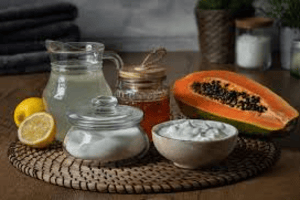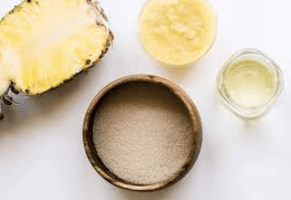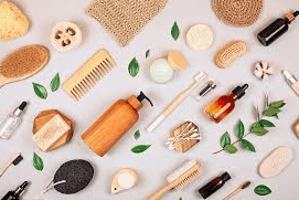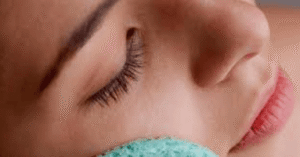Your skin is constantly renewing itself, shedding dead cells to make way for fresh ones underneath. This natural process slows with age and environmental factors, leaving your skin looking dull and feeling rough.
Learning how to remove dead skin cells naturally isn’t just about achieving glowing skin—it’s about supporting your body’s largest organ in its vital functions. Natural exfoliation methods can transform your complexion without harsh chemicals, using ingredients you likely already have at home.
Let’s explore gentle yet effective approaches that honor your skin’s delicate balance while revealing the radiant complexion hiding beneath those dead skin cells.

Understanding Your Skin’s Natural Renewal Process
Our skin naturally sheds dead cells in a process called desquamation. This cycle typically takes about 28 days in younger adults but can slow to 40-60 days as we age. When dead skin cells accumulate:
- They form a barrier that keeps moisturizers from getting inside the skin
- Skin appears dull and rough
- Pores become clogged, leading to breakouts
- There are more noticeable fine lines and wrinkles.
The type of skin you have has a big impact on how you should approach removing dead skin
cells naturally. Exfoliation methods vary depending on the type of skin:
Dry skin benefits from gentle, moisturizing exfoliants that don’t strip natural oils
Oily skin often needs more frequent exfoliation to prevent clogged pores
Sensitive skin requires ultra-gentle methods to avoid irritation
Combination skin may need targeted exfoliation in different areas
Benefits of Natural Exfoliation Methods
Using natural methods to remove dead skin cells offers numerous advantages over commercial products:
- Free from harsh chemicals that can disrupt your skin’s pH
- Environmentally friendly alternatives to microbeads
- Cost-effective solutions using common household ingredients
- Customizable to your specific skin needs
- Rich in nutrients that nourish while exfoliating
Natural exfoliation supports healthy skin by:
- Improving circulation to bring nutrients to skin cells
- Stimulating collagen production for firmer skin
- Improving other skincare products’ effectiveness
- Preventing ingrown hairs and clogged pores
- Making the makeup application skin surface smoother
Top Kitchen Ingredients for Natural Exfoliation
Your kitchen is filled with powerful exfoliants that can remove dead skin cells effectively:
Honey
This natural humectant not only moisturizes but contains gentle enzymes that dissolve dead skin cells.
- Apply raw honey to clean, damp skin
- For one to two minutes, massage lightly in circular strokes.
- Then leave on for 15 to 20 minutes before washing with warm water.
- Great for dry and sensitive skin types
 Sugar
Sugar
The small granules in sugar make it an excellent physical exfoliant.
- Mix organic sugar with olive oil or coconut oil to create a paste
- Gently massage onto skin using circular motions
- Rinse thoroughly with warm water
- Perfect for normal to oily skin types body exfoliation
Coffee Grounds
Used coffee grounds not only remove dead skin cells but contain caffeine that temporarily tightens skin.
- Mix coffee grounds which have been used with coconut oil
- Gently massage onto damp skin
- Concentrating on rough spots like the elbows, knees, and ankles.
- Excellent for stimulating circulation and reducing cellulite appearance
Oatmeal
A gentle exfoliant that soothes while it smooths:
- Pure oatmeal should be ground into a fine powder.
- Mix with water, honey, or yogurt to form a paste
- Apply to face and body, massaging gently
- Perfect for sensitive and irritated skin
Baking Soda
Its fine texture makes it effective yet gentle:
- Create a paste with water (1:2 ratio of baking soda to water)
- Apply to damp skin with light fingertip pressure
- Limit use to once weekly as it can be drying
- Effective in treating blackheads and oily skin
Fruit-Based Exfoliation Methods
Fruits contain natural acids that dissolve the bonds between dead skin cells:
 Papaya
Papaya
Includes the papain enzyme, which breaks down dead skin naturally:
- Apply the smooth paste made from mashed ripe papaya to clean skin
- Allow it on the skin for 10 to 15 minutes.
- Rinse with cool water
- Helps with hyperpigmentation and dull skin
Pineapple
Rich in bromelain enzyme with powerful exfoliating properties:
- Apply fresh pineapple juice or pulp to skin
- For sensitive skin, let it stay for 5-10 minutes or normal skin for 15-20 minutes
- Rinse thoroughly
- Excellent for brightening complexion
Strawberries

Strawberries’ salicylic acid aids in pore clearing:
- Mash 3-4 strawberries into a paste
- Mix with honey for added benefits
- Apply to face for 10-15 minutes
- Particularly beneficial for acne-prone skin
Lemon
Lemon’s citric acid exfoliates and brightens:
- Use equal amounts of water to dilute fresh lemon juice.
- Apply to areas with dead skin buildup after soaking with cotton balls
- Rinse after 5-10 minutes and apply sunscreen (lemon increases sun sensitivity)
- Best used at night and not for sensitive skin
DIY Natural Exfoliating Masks and Scrubs
Create these effective masks and scrubs to remove dead skin cells:
Yogurt and Honey Mask
- 2 tablespoons unsweetened yogurt (contains lactic acid)
- 1 tablespoon raw honey
- Mix ingredients and apply to clean face
- Leave for 15-20 minutes before rinsing
- Hydrates while removing dead skin cells
Brown Sugar and Olive Oil Scrub
- ¼ cup brown sugar
- 3 tablespoons olive oil
- Add 5 drops any essential oil of choice (optional)
- Keep in a well-covered jar after mixing the ingredients well
- Use 1-2 times weekly for body exfoliation
Avocado and Oatmeal Mask
- ½ ripe avocado
- 2 tablespoons ground oatmeal
- 1 teaspoon honey
- Mash and mix all ingredients
- Apply to face for 15 minutes
- Exfoliates while deeply moisturizing
Rice Flour and Green Tea Scrub
- 2 tablespoons rice flour
- 1 tablespoon brewed green tea (cooled)
- Mix into a paste
- Gently massage onto face and neck
- Rinse after 10 minutes
- Brightens complexion and reduces inflammation
Natural Exfoliation Tools
Beyond ingredients, these natural tools effectively remove dead skin:
Dry Brushing
- Purchase a natural bristle brush
- Use on dry skin before showering
- Use lengthy brushstrokes in the direction of the heart.
- Start with limbs and work toward center of body
- Advantages include enhanced lymphatic drainage and circulation.

Konjac Sponge
- Made from natural konjac root fibers
- Soak until soft before using
- Gently massage face in circular motions
- Naturally alkaline to balance skin pH
- Available in different varieties for specific skin types
Muslin Cloth
- Dampened with warm water
- Use in conjunction with a cleanser to get rid of dead skin and makeup.
- Gentle enough for daily use
- Machine washable and environmentally friendly
Loofah
- Natural plant fiber that exfoliates effectively
- Apply wet on the body with soap or body wash.
- Focus on rough areas like elbows and feet
- Replace every 3-4 weeks to prevent bacteria growth
Creating an Effective Natural Exfoliation Routine
For sustainable results, develop a consistent routine:
For Face
- Exfoliate 1-2 times weekly for normal/oily skin
- Limit to once weekly for sensitive/dry skin
- Always follow with moisturizer
- Perform at night to allow skin recovery time
- Frequency of exfoliation should depend on skin response and seasonal changes.
For Body
- Exfoliate 2-3 times weekly
- Focus on rough areas like elbows, knees, feet
- Apply body oil or lotion immediately after
- Increase frequency in summer when skin cells turn over faster
- Decrease in winter when skin tends to be drier
Key Times to Exfoliate
- Before applying self-tanner for even results
- Before shaving to prevent ingrown hairs
- When skin appears dull or feels rough
- When seasonal changes affect skin texture
- Before special events for a natural glow
Post-Exfoliation Care
After removing dead skin cells, proper care maximizes benefits:
- Use moisturizers with natural ingredients like aloe vera, shea butter, or jojoba oil
- Use broader spectrum sunscreen as newly revealed skin is more sun-sensitive
- Let the skin rest for 2 days before using retinol products
- Drink plenty of water to support new cell generation
- Consume antioxidant-rich foods to protect fresh skin cells

Preventing Dead Skin Cell Buildup Naturally
To address the underlying causes of excessive accumulation of dead skin cells:
- Drink enough water (at least 8 cups) each day
- Eat a well-rounded diet rich in vitamins A, C, and E.
- Get enough sleep to promote skin renewal.
- Practice yoga, meditation, or other relaxation techniques to lower stress.
- Protect skin from excessive sun exposure and environmental pollutants
Special Considerations for Different Skin Concerns
Adapt natural exfoliation methods for specific issues:
For Keratosis Pilaris (Chicken Skin)
- Use gentle exfoliants containing lactic acid like yogurt
- Apply coconut oil after exfoliation
- Exfoliate consistently but gently
For Mature Skin
- Focus on enzyme exfoliants rather than physical scrubs
- Include antioxidant-rich ingredients like green tea
- Emphasize moisturization post-exfoliation
For Hyperpigmentation
- Incorporate brightening agents like lemon juice (diluted) or licorice root
- To prevent irritability, be consistent but gentle.
- Always follow with sun protection
For Acne-Prone Skin
- Use antibacterial options like honey or tea tree oil
- Refrain from over-exfoliation as this may increase the production of oil.
- Focus on ingredients that reduce inflammation
When to See a Dermatologist
While natural methods work well for most people, consult a professional if:
- Your skin remains rough despite consistent exfoliation
- You experience persistent redness or irritation
- You suffer from a skin disorder such as rosacea, psoriasis, or eczema.
- You notice unusual changes in skin texture or appearance
- Natural methods seem to worsen your skin issues
FAQs
How often should I exfoliate my face naturally?
Exfoliating 1-2 times a week is adequate for the majority of skin types. Those with sensitive skin may benefit from just once weekly, while oilier skin types might need up to 3 times weekly. Over-exfoliation can damage your skin barrier, leading to sensitivity and irritation.
If you notice redness, tightness, or increased sensitivity, reduce frequency immediately. The idea is to promote your skin’s natural renewal process, not overpower it.
Can I use the same natural exfoliants for my face and body?
While many natural exfoliants can work for both face and body, the skin on your face is generally more sensitive and requires gentler approaches. Body exfoliants often contain larger particles or stronger concentrations that may be too harsh for facial skin.
For example, coffee grounds work wonderfully for body scrubs but might be too abrasive for the face. Fruit enzymes and yogurt make excellent facial exfoliants, while sugar and salt scrubs are better suited for tougher body skin.
Are natural exfoliants effective for severe dry skin and flakiness?
Natural exfoliants can be very effective for dry, flaky skin when used correctly. For severe dryness, focus on humectant-rich exfoliants like honey combined with gentle physical exfoliation from ingredients like ground oatmeal.
After exfoliating, immediately apply natural oils like avocado or argan oil to seal in moisture. For persistent severe dryness, alternate between gentle exfoliation and intensive hydration treatments.
How do I know if I’m over-exfoliating?
Signs of over-exfoliation include increased sensitivity, redness, tightness, shininess without oiliness, transparent-looking skin, or breakouts in unusual areas. Your skin might feel irritated or ‘burn’ when applying normally tolerated products.
If you notice these symptoms, immediately stop exfoliating and focus on restoring your skin barrier with gentle, fragrance-free moisturizers containing ceramides or hyaluronic acid. Once your skin recovers, reintroduce exfoliation at a reduced frequency using gentler methods.
Can dark spots and acne scars be improved by natural exfoliation?
Natural exfoliation can gradually improve the appearance of acne scars and dark spots by removing dead skin cells that make these imperfections more noticeable. Ingredients like papaya, pineapple and lemon contain natural acids and enzymes that promote cell turnover and have mild lightening effects.
For best results, be consistent but patient—natural methods typically show improvement over weeks or months rather than days. Combine exfoliation with sun protection, as UV exposure can darken scars and spots.
For significant scarring, natural methods may help but consider complementing them with professional treatments for more dramatic results.
Conclusion…
Exfoliating dead skin cells naturally is an empowering way to care for your skin while avoiding harsh chemicals. By incorporating ingredients from your kitchen, establishing a consistent routine, and responding to your skin’s changing needs, you can reveal your natural radiance.
Remember that exfoliation is just one component of healthy skin—hydration, nutrition, and sun protection are equally important. Embrace these natural approaches as part of your self-care ritual and enjoy the process of nurturing your skin’s inherent ability to renew itself.



